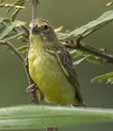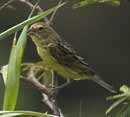 Click on either of these two images to obtain a larger version.
Click on either of these two images to obtain a larger version.

Last Modified: March 10, 2004.
Click on the links at the top of each column in the table to go to the appropriate gallery. If you click on the individual names, you'll load just the appropriate image in a new window. The galleries show thumbnails of all the images and the image views in the galleries contain short descriptions of each.
Since we were stuck in Miami for one night, we figured why not stay for more, and see the Everglades, Corkscrew Swamp, et cetera? Thus we planned three nights in Florida before we left for Trinidad and Tobago.
We spent the first night near the airport and early the next morning drove to Shark Valley which is on the northernmost part of the Everglades National Park. It was fabulous! It's basically a long, almost straight trail that goes south for about 7 miles with great wildlife all the way along it. We were going so slowly and having such great camera opportunities that we probably walked less than 2 miles south. By then it was starting to get hot and we decided that our best bet would be to hike back and drive to the Ding Darling reserve near Fort Myers on the west side of the Florida peninsula which took a couple of hours. After obtaining a motel room, et cetera, we got to Ding Darling at about 4:30 pm, and it was a bit disappointing. The sun was directly in our eyes for all the interesting wildlife. In the morning, it would probably have been great.
We spent the night and early the next morning went to Corkscrew Swamp. This was also fabulous. We spent most of the day there, hiking on the boardwalk, and saw an amazing number of birds, including our first view of the American Bittern. There were lots of experienced birders there as well as a lot of docents, and everyone we met was extremely helpful, and as a result we saw far more than we would have seen, left to our own devices.
At the end of the day, we drove to Florida City (the closest city to the entrance to the southern part of the Everglades) and spent the night. We were up at 4:00 am so that we could drive all the way to Flamingo and Eco Lake for sunrise there. We saw a lot of stuff, and then as the day went on, we birded our way back toward Miami, constantly looking at our watches to make sure we'd have enough time to turn in the rental car and catch our 4:00 pm flight to Port of Spain, Trinidad.
In Trinidad, Asa Wright was, as promised, great! We have absolutely no complaints, and in retrospect, should have spent more time there. We went to the Nariva Swamp, the Caroni Marsh, and spent a lot of time just on the center's grounds. We would have liked to have done a trip to Blanchisseuse Road, but there was no time.
The trip to Tobago was not so great. We stayed at the Blue Waters Inn, and there were problems. It's aimed more at scuba divers and not at birders. I think that in the past it was better for birders, but no longer. The bird feeders have been neglected for at least 6 months (according to the comments in the visitors' log). They're not refilled, and many are broken.
There are no good nearby trails for birding. You can walk the roads, but near the inn, they were not spectacular. At Asa Wright, it was trivial to obtain guides for any sort of birding trip you wanted; at the inn, you had to go to some work. We did OK there, but part of that was luck. We spoke to other birders who had gone to Little Tobago Island with a guide who didn't even know the names of the birds.
Finally, the schedule is not aimed at birders. Breakfast, for example, was at 8:00 am, long after birders should be on the road. In theory, you can arrange for an early breakfast, but the one time we tried, the staff "forgot", so we went on a seven hour birding trip on an empty stomach which was not much fun.
We also had bad luck with a broken flooding toilet which could happen to anyone, but the initial response from the staff member was that there was nothing she could do because it was too late to call a plumber. We had to suggest to her that maybe she could move us to a room with a working toilet. This required two trips since the first "new" room was not made up: bed unmade, dirty towels, and Jack Daniels bottles all over. The second new room was also missing towels, but we gave up at that point and just put up with it.
The food was good, but overall, considering the relatively high price and the fact that it no longer seems to cater to birders, I would not recommend it. We met some people who stayed at the Cuffie River Nature Retreat in Tobago, and gave it exceptional reviews, so that might be a place worth considering.
Luckily, his father was nearby, acting as the local guide for another birding group, and we brought them over to see the bird. His father, the other Trinidadian birding god, also had never seen it. Then Megan Crewe, the American leader of the group, who had been to Venezuela, thought it was the Grassland Yellow Finch (Sicalis luteola), never before seen in Trinidad. We checked the guide to Venezuela birds, and sure enough--Megan seemed to have nailed it.
I had my camera along, and although the bird never got very close to us, I was able to obtain the two shots below, which, although they'll never make the cover of National Geographic Magazine, are probably good enough for an identification. Megan obtained recordings of the calls, and the information has been passed on to the Trinidad and Tobago rare bird society. We saw about 20 birds, and the next day, Mahase returned and found at least 50 of them, so they're almost certainly breeding in Trinidad.
 Click on either of these two images to obtain a larger version.
Click on either of these two images to obtain a larger version.
